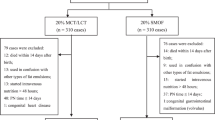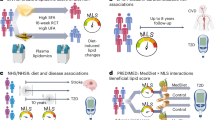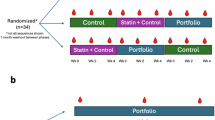Abstract
This study investigates whether improved quality of nutrients during early postnatal life has effects on adult metabolic profile and body composition in a murine model of nutritional programming. Male offspring of C57Bl/6j dams received a diet containing 21% energy (En%) as fat of either 100% vegetable oils [control (CTRL)] or 80% vegetable oils/20% tuna fish oil [rich in n-3 long-chain polyunsaturated fatty acids (n-3 LCP)] from postnatal day (PN) 2 to 42. Subsequently, mice of both experimental groups were switched to a western style diet (WSD; 21 En% fat, high saturated fatty acid [FA] content, and cholesterol) until dissection at PN98. Body composition was analyzed by dual x-ray absorptiometry during the WSD challenge. Results showed that a n-3 LCP-rich diet during postnatal life not only reduced fat accumulation by ∼30% during the WSD challenge from PN42 to 98 (p < 0.001) but also led to a healthier plasma lipid profile, healthier plasma glucose homeostasis, and less hypertrophic adipocytes compared with CTRL. This study shows that postnatal nutrition has programming effects on adult body composition and metabolic homeostasis. In addition, it emphasizes that moderate alterations in fat quality during early postnatal life considerably affect adult metabolic health.
Similar content being viewed by others
Log in or create a free account to read this content
Gain free access to this article, as well as selected content from this journal and more on nature.com
or
Abbreviations
- ARA:
-
arachidonic acid
- BW:
-
body weight
- CRL:
-
crown-rump length
- CTRL:
-
control
- DEXA:
-
dual energy x-ray absorptiometry
- DHA:
-
docosahexaenoic acid
- FA:
-
fatty acids
- FM:
-
fat mass
- HOMA-IR:
-
homeostasis model assessment of insulin resistance
- LCP:
-
long-chain polyunsaturated fatty acids
- PN:
-
postnatal day
- TG:
-
triglycerides
- WAT:
-
white adipose tissue
- WSD:
-
western style diet.
References
Berghöfer A, Pischon T, Reinhold T, Apovian CM, Sharma AM, Willich SN 2008 Obesity prevalence from a European perspective: a systematic review. BMC Public Health 8: 200
Sturm R 2007 Increases in morbid obesity in the USA: 2000–2005. Public Health 121: 492–496
Balakrishnan R, Webster P, Sinclair D 2008 Trends in overweight and obesity among 5–7-year-old White and South Asian children born between 1991 and 1999. J Public Health (Oxf) 30: 139–144
Li C, Ford ES, Mokdad AH, Cook S 2006 Recent trends in waist circumference and waist-height ratio among US children and adolescents. Pediatrics 118: e1390–e1398
Willett WC, Leibel RL 2002 Dietary fat is not a major determinant of body fat. Am J Med 113: 47S–59S
Burdge GC, Calder PC 2006 Dietary alpha-linolenic acid and health-related outcomes: a metabolic perspective. Nutr Res Rev 19: 26–52
Ailhaud G, Massiera F, Weill P, Legrand P, Alessandri JM, Guesnet P 2006 Temporal changes in dietary fats: role of n-6 polyunsaturated fatty acids in excessive adipose tissue development and relationship to obesity. Prog Lipid Res 45: 203–236
Massiera F, Saint-Marc P, Seydoux J, Murata T, Kobayashi T, Narumiya S, Guesnet P, Amri EZ, Negrel R, Ailhaud G 2003 Arachidonic acid and prostacyclin signaling promote adipose tissue development: a human health concern?. J Lipid Res 44: 271–279
Taylor PD, Poston L 2007 Developmental programming of obesity in mammals. Exp Physiol 92: 287–298
Gluckman PD, Hanson MA, Cooper C, Thornburg KL 2008 Effect of in utero and early-life conditions on adult health and disease. N Engl J Med 359: 61–73
Vickers MH, Gluckman PD, Coveny AH, Hofman PL, Cutfield WS, Gertler A, Breier BH, Harris M 2005 Neonatal leptin treatment reverses developmental programming. Endocrinology 146: 4211–4216
Wyrwoll CS, Mark PJ, Mori TA, Puddey IB, Waddell BJ 2006 Prevention of programmed hyperleptinemia and hypertension by postnatal dietary omega-3 fatty acids. Endocrinology 147: 599–606
Roggero P, Gianni ML, Amato O, Orsi A, Piemontese P, Morlacchi L, Mosca F 2009 Is term newborn body composition being achieved postnatally in preterm infants?. Early Hum Dev 85: 349–352
Euser AM, Finken MJ, Keijzer-Veen MG, Hille ET, Wit JM, Dekker FW 2005 Associations between prenatal and infancy weight gain and BMI, fat mass, and fat distribution in young adulthood: a prospective cohort study in males and females born very preterm. Am J Clin Nutr 81: 480–487
Ibáñez L, Ong K, Dunger DB, de Zegher F 2006 Early development of adiposity and insulin resistance after catch-up weight gain in small-for-gestational-age children. J Clin Endocrinol Metab 91: 2153–2158
Martin-Gronert MS, Ozanne SE 2007 Experimental IUGR and later diabetes. J Intern Med 261: 437–452
Sullivan EL, Grove KL 2010 Metabolic imprinting in obesity. Forum Nutr 63: 186–194
Armitage JA, Taylor PD, Poston L 2005 Experimental models of developmental programming: consequences of exposure to an energy rich diet during development. J Physiol 565: 3–8
Simoncíkova P, Wein S, Gasperikova D, Ukropec J, Certik M, Klimes I, Sebokova E 2002 Comparison of the extrapancreatic action of gamma-linolenic acid and n-3 PUFAs in the high fat diet-induced insulin resistance [Corrected]. Endocr Regul 36: 143–149
Storlien LH, Jenkins AB, Chisholm DJ, Pascoe WS, Khouri S, Kraegen EW 1991 Influence of dietary fat composition on development of insulin resistance in rats. Relationship to muscle triglyceride and omega-3 fatty acids in muscle phospholipid. Diabetes 40: 280–289
Halvorsen B, Rustan AC, Madsen L, Reseland J, Berge RK, Sletnes P, Christiansen EN 2001 Effects of long-chain monounsaturated and n-3 fatty acids on fatty acid oxidation and lipid composition in rats. Ann Nutr Metab 45: 30–37
Flachs P, Rossmeisl M, Bryhn M, Kopecky J 2009 Cellular and molecular effects of n-3 polyunsaturated fatty acids on adipose tissue biology and metabolism. Clin Sci (Lond) 116: 1–16
Helland IB, Smith L, Saarem K, Saugstad OD, Drevon CA 2003 Maternal supplementation with very-long-chain n-3 fatty acids during pregnancy and lactation augments children's IQ at 4 years of age. Pediatrics 111: e39–e44
Damsgaard CT, Lauritzen L, Kjaer TM, Holm PM, Fruekilde MB, Michaelsen KF, Frokiaer H 2007 Fish oil supplementation modulates immune function in healthy infants. J Nutr 137: 1031–1036
Weisinger HS, Armitage JA, Sinclair AJ, Vingrys AJ, Burns PL, Weisinger RS 2001 Perinatal omega-3 fatty acid deficiency affects blood pressure later in life. Nat Med 7: 258–259
Korotkova M, Gabrielsson BG, Holmang A, Larsson BM, Hanson LA, Strandvik B 2005 Gender-related long-term effects in adult rats by perinatal dietary ratio of n-6/n-3 fatty acids. Am J Physiol Regul Integr Comp Physiol 288: R575–R579
Reeves PG, Nielsen FH, Fahey GC Jr 1993 AIN-93 purified diets for laboratory rodents: final report of the American Institute of Nutrition ad hoc writing committee on the reformulation of the AIN-76A rodent diet. J Nutr 123: 1939–1951
Levant B, Ozias MK, Carlson SE 2007 Diet (n-3) polyunsaturated fatty acid content and parity affect liver and erythrocyte phospholipid fatty acid composition in female rats. J Nutr 137: 2425–2430
Baur LA, O'Connor J, Pan DA, Wu BJ, O'Connor MJ, Storlien LH 2000 Relationships between the fatty acid composition of muscle and erythrocyte membrane phospholipid in young children and the effect of type of infant feeding. Lipids 35: 77–82
Ryan AS, Montalto MB, Groh-Wargo S, Mimouni F, Sentipal-Walerius J, Doyle J, Siegman JS, Thomas AJ 1999 Effect of DHA-containing formula on growth of preterm infants to 59 weeks postmenstrual age. Am J Hum Biol 11: 457–467
Innis SM, Adamkin DH, Hall RT, Kalhan SC, Lair C, Lim M, Stevens DC, Twist PF, Diersen-Schade DA, Harris CL, Merkel KL, Hansen JW 2002 Docosahexaenoic acid and arachidonic acid enhance growth with no adverse effects in preterm infants fed formula. J Pediatr 140: 547–554
Siemelink M, Verhoef A, Dormans JA, Span PN, Piersma AH 2002 Dietary fatty acid composition during pregnancy and lactation in the rat programs growth and glucose metabolism in the offspring. Diabetologia 45: 1397–1403
Kim HK, Della-Fera M, Lin J, Baile CA 2006 Docosahexaenoic acid inhibits adipocyte differentiation and induces apoptosis in 3T3–L1 preadipocytes. J Nutr 136: 2965–2969
Pérez-Matute P, Perez-Echarri N, Martinez JA, Marti A, Moreno-Aliaga MJ 2007 Eicosapentaenoic acid actions on adiposity and insulin resistance in control and high-fat-fed rats: role of apoptosis, adiponectin and tumour necrosis factor-alpha. Br J Nutr 97: 389–398
Raclot T, Groscolas R, Langin D, Ferre P 1997 Site-specific regulation of gene expression by n-3 polyunsaturated fatty acids in rat white adipose tissues. J Lipid Res 38: 1963–1972
Wang P, Mariman E, Renes J, Keijer J 2008 The secretory function of adipocytes in the physiology of white adipose tissue. J Cell Physiol 216: 3–13
Pérez-Echarri N, Perez-Matute P, Marcos-Gomez B, Baena MJ, Marti A, Martinez JA, Moreno-Aliaga MJ 2008 Differential inflammatory status in rats susceptible or resistant to diet-induced obesity: effects of EPA ethyl ester treatment. Eur J Nutr 47: 380–386
Browning LM, Krebs JD, Moore CS, Mishra GD, O'Connell MA, Jebb SA 2007 The impact of long chain n-3 polyunsaturated fatty acid supplementation on inflammation, insulin sensitivity and CVD risk in a group of overweight women with an inflammatory phenotype. Diabetes Obes Metab 9: 70–80
Khaodhiar L, Ling PR, Blackburn GL, Bistrian BR 2004 Serum levels of interleukin-6 and C-reactive protein correlate with body mass index across the broad range of obesity. JPEN J Parenter Enteral Nutr 28: 410–415
Sopasakis VR, Sandqvist M, Gustafson B, Hammarstedt A, Schmelz M, Yang X, Jansson PA, Smith U 2004 High local concentrations and effects on differentiation implicate interleukin-6 as a paracrine regulator. Obes Res 12: 454–460
Acknowledgements
We thank Prof. Henriette Delemarre-Van de Waal, Department of Pediatrics, Leiden University Medical Center, Leiden, The Netherlands, for reviewing this article.
Author information
Authors and Affiliations
Corresponding author
Rights and permissions
About this article
Cite this article
Oosting, A., Kegler, D., Boehm, G. et al. N-3 Long-Chain Polyunsaturated Fatty Acids Prevent Excessive Fat Deposition in Adulthood in a Mouse Model of Postnatal Nutritional Programming. Pediatr Res 68, 494–499 (2010). https://doi.org/10.1203/PDR.0b013e3181f74940
Received:
Accepted:
Issue date:
DOI: https://doi.org/10.1203/PDR.0b013e3181f74940
This article is cited by
-
Als ik straks de krant maar haal
Huisarts en wetenschap (2014)
-
Breast milk fatty acid profile in relation to infant growth and body composition: results from the INFAT study
Pediatric Research (2013)
-
Size and phospholipid coating of lipid droplets in the diet of young mice modify body fat accumulation in adulthood
Pediatric Research (2012)
-
Development of the Digestive System—Experimental Challenges and Approaches of Infant Lipid Digestion
Food Digestion (2012)
-
A More Breast Milk-Like Infant Formula Reduces Excessive Body Fat Accumulation in Adult Mice
Pediatric Research (2011)



